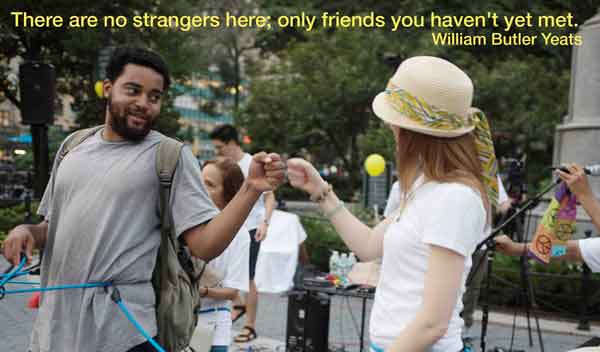
In my position as a Community College instructor, I often read ESL college placement exams. A theme that I encounter again and again is how living in the USA is a lonely experience. People attend college for a variety of reasons, one of which is a simple desire for better communication. Even my degree-seeking students express loneliness and mention a desire for more friendship. They seem to think that speaking the language or understanding the cultural guarantees acceptance and friendship. However, maintaining relationships in today’s frantic, busy America takes more than just a desire for communication; it takes dedication, time, and hard work! Common interests help move things along as well. Today’s blog offers practical tips for making the connections of friendship in the USA.
1) When seeking connections with others, it helps if you have common interests. For college students, school clubs and activities abound. On your school website, you can search for “clubs,” “school activities,” or “student life.” Most colleges will have a listing of such. Irvine Valley College, where I am currently teaching, has groups based on languages like English or French, academic topics like Geography or Business, religious preferences like the Christian or Muslin association, and special interests like music and bees. If you can’t find something you are interested in, many schools even allow you to start your own club! One of the awesome things about live here is that there is usually someone somewhere who is interested in the same things as you are!


2) Once you are actively looking for others to communicate with, the first steps of friendship are sharing smiles and ideas. Practical tips on starting conversations with others can be found in this blog post.
3) It is also important to understand that everyone around you is busy with work, school, and families. In Southern California specifically, life is very expensive, and most people work a great to deal to be able to live here. On top of that, many commute long distances from work to home. I drive between 45 minutes to 1 ½ hours one way to work, and Mr. C’s daily commute is even longer than mine! This is simply a normal part of life today. What this means is that despite the importance of friendship, only so much time and effort can be spent on it. I have several good friends that I only see two or three times a year. With all the teaching, grading, and taking care of families, there is just not that much time for friendship. This is the nature of many American friendships.

First, discuss general things in public settings with casual conversation. It can, of course, be personal, but you don’t share the intimate details of your life at this stage. Thus for, example, you might talk about your job but not about the fact that you aren’t sure how you are going to pay the rent this month.

Then, you start to share more details of your own life like personal stories, concerns, happenings, etc. It is at this point that you may join social media accounts and start to get to know someone more deeply. You might communicate regularly this way outside of your common event. Up till now, the person is an acquaintance rather than a friend.
From that point on, the relationship can continue to grow if both people invest time and energy. For me, these are the friends I regularly reach out to in good times and bad. The more time spent together, the deeper the friendship. However, it can’t be just one-sided. If only one person reaches out regularly, the relationship will slowly wither.
If things continue to go well, then you may meet outside of the regular environment, for coffee or lunch for instance. You might meet a study group off campus. At this point, maybe you have exchanged phone numbers and are texting regularly. I would call someone at this stage a friend.
As you become more acquainted, it is now that you might have someone over to your home for a visit or meal. For me, this is a big step. I don’t invite anyone over to my house unless it is someone that I truly like and want to spend more time with. Once someone has come to my home and I have been to her home, the level of friendship has deepened into a good friendship.
4) American friendships develop through several stages. Partially because of the busy pace of lifestyle and partially for cultural reasons, making friends can take time. People may become uneasy or feel pressured if someone takes things too fast. While not everyone follows these exact stages, here are some of the steps that I have experienced in the development of friendships.

5) The final important thing to understand about American friendships is that they seem to be much shorter than those from other countries. It is not that Americans are shallow, but they are super busy. If someone is not around, it is easy to let a friendship fade rather than making an extreme effort to keep it going. This is commonly seen in colleges with the semester- buddy phenomena. In a class, one can become bosom buddies very quickly, moving through the friendship stages and seeming like best friends in a matter of weeks rather than months. However, once the semester is over, the friendship often ends or moves back just to an online connection. I had some fantastic friends while in college, and I value what I learned from them and what we shared even today, but only one of all those relationships is still active, and that is primarily because we have taught together as well. Similar friendships occur in the workplace. For example, during the 3 1/2 years that I worked at UCI, I had what I considered good friendships with several colleagues; now, however, the extent of our friendships now is liking each others’ posts on Facebook. It is important to note that those friendships were genuine and valuable despite their brief nature. Duration does not necessarily equate to quality these days.
























